![]()
![]()
![]()
Use LEFT and RIGHT arrow keys to navigate between flashcards;
Use UP and DOWN arrow keys to flip the card;
H to show hint;
A reads text to speech;
70 Cards in this Set
- Front
- Back
|
Mater exists primarily in 3 phases:
|
- solids
- liquids - gas |
|
|
Intermolecular Forces:
|
[attractive forces that exist between all molecules & atoms]
- forces that hold many liquids & solids - responsible for the very existence of the condensed phases. |
|
|
Thermal Energy:
|
the energy associated with the random motion of matter.
|
|
|
Table 11.1: Shows the density & molar vol. of water in its 3 different phases, along with molecular representation of each phase
|

|
|
|
Table 11.2: Properties of the Phases of Matter
|

|
|
|
In what two orders can a solid be?
|
1- Crystalline
2- Amorphous |
|
|
Crystalline:
|
The atoms or molecules that compose them are arranged in a well-ordered 3D array
|
|
|
Amorphous:
|
the atoms or molecules that compose them have no long-range order.
|
|
|
Shows the 3 states of matter and the changes in conditions that commonly induce transitions between them
|
|
|
|
Shows the 3 states of matter and the changes in conditions that commonly induce transitions between them
|

|
|
|
Gases are Compressible
|

|
|

Conceptual Connection 11.1: Phase Changes
|
(A) When water boils, it simply changes phases from liquid to gas. Water molecules do not decompose during boiling.
|
|
|
Intermolecular forces are the result of:
|
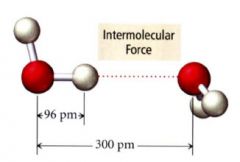
Smaller charges interacting at greater distances
|
|
|
Dispersion Force (AKA London Force)
|

- present in all molecules & atoms
- result of fluctuations in the e- distribution w/ in molecules or atoms. |
|
|
Instantaneous Dipole/ Temporary Dipole:
|
at an instant, one side of the atom will be slightly (-) while other side w/ no e-s will be slightly (+).
will induce an instantaneous dipole on its neighboring atom b/c the (+) end of the instantaneous dipole attracts e-s in the neighboring atoms. (cont. from atom to atom... creating the dispersion force) |
|
|
What does the magnitude of the dispersion force depend on?
|
- how easily the e-s in the atom/ molecule can move or polarize in response to an instantaneous dipole.
--------> depends on the size (vol) of the e- cloud |
|
|
Why do larger molecules have greater dispersion force?
|
because they have larger e- clouds
e- are held less tightly by the nucleus & can therefore polarize easier. |
|
|
How to determine whether a molecule is polar:
|
1) determine whether the molecule contains polar bonds
2) determine whether the polar bonds add together to form a net dipole moment. |
|
|
Characteristics of polar molecules:
|
- high melting pts.
- high boiling pts. - dispersion forces - dipole-dipole forces |
|
|
The relationship between dipole moment and boiling pt.
|

|
|
|
Miscibility:
|
the ability to mix without separating into two phases - of liquid.
"like dissolves like" |
|
|
In what elements does h-bonding occur?
|
- Fluorine (F)
- Oxygen (O) - Nitrogen (N) |
|
|
Hydrogen bond:
|
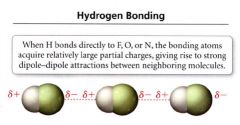
a strong attraction between the hydrogen in each molecule & the F,O,N on its neighbors.
|
|
|
graph showing relation of H-bond and other molecules with their molecular mass and boiling pt.
|

|
|
|
Ion-dipole force:
|

- occurs when an ionic compound is mixed w/ a polar compound
- is especially important in aqueous solutions of ionic compounds. |
|
|
Types of Intermolecular Forces:
|
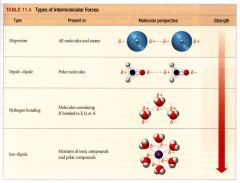
|
|
|
surface tension of a liquid:
|
the energy required to increase the surface area by a unit amount.
|
|
|
If intermolecular forces decrease, surface tension will?
|
decrease
|
|
|
Viscosity:
|
the resistance of a liquid to flow
|
|
|
as intermolecular forces increase, viscosity will?
|
increase
|
|
|
as temperature increases, viscosity will?
|
decrease
|
|
|
Capillary action:
|
the ability of a liquid to flow against gravity up a narrow tube.
- results from a combination of cohesive forces, and adhesive forces. |
|
|
cohesive forces:
|
the attraction between molecules in a liquid
|
|
|
adhesive forces:
|
the attraction between theses molecules and the surface of the tube
|
|
|
Vaporization:
|
the process by which thermal energy can overcome intermolecular forces & produce a phase change from liquid to gas.
- the phase transition from liquid to gas |
|
|
Condensation:
|
the phase transition from gas to liquid.
|
|
|
as temperature increase, vaporization?
|
increases
|
|
|
as intermolecular forces decrease, vaporization?
|
increases
|
|
|
as surface area increases, vaporization?
|
increases
|
|
|
volatile liquids:
|
vaporize easily
|
|
|
nonvolatile liquids:
|
do not vaporize easily
|
|
|
summarizing the process of vaporization:
|
- the rate of vaporization increases with increasing temperature
- the rate of vaporization increases with increasing surface area - the rate of vaporization increases with decreasing strength of intermolecular forces. |
|
|
energy distribution curve
|

|
|
|
why is vaporization endothermic?
|
because it take energy to vaporize the molecules in a liquid
|
|
|
why is condensation exothermic?
|
because heat is released when a gas condenses to liquid.
|
|
|
heat of vaporization:
|
- the amount of heat required to vaporize one mole of a liquid to gas
- always (+) b/c the process is endothermic - somewhat temperature dependent. |
|
|
vapor pressure:
|
pressure of a gas in dynamic equilibrium w/ its liquid.
- depends on the intermolecular forces present in the liquid & the temp. |
|
|
dynamic equilibrium
|
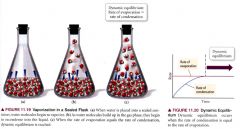
|
|
|
When the temperature of a liquid increases, what happens to the vapor pressure?
|
it increases
|
|
|
boiling pt. of a liquid:
|
the temp @ which its vapor pressure = the external pressure
|
|
|
normal boiling pt. of a liquid:
|
the temp. @ which its vapor pressure = 1atm
|
|
|
critical temperature:
|
the temp. above which the liquid cannot exist
|
|
|
critical pressure:
|
the pressure required to bring about a transition to a liquid at a critical temp.
|
|
|
supercritical fluid:
|
when gas and liquid phase commingle
|
|
|
Sublimation:
|
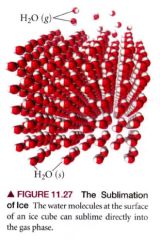
The phase transition from solid to gas
|
|
|
deposition:
|
the phase transition from gas to solid
|
|
|
Melting pt.:
|
molecules have enough thermal energy to overcome the intermolecular forces that hold them @ their stationary pts. & solid turns into liquid.
- process is called melting |
|
|
Fusion (melting):
|
the phase transition from solid to liquid
|
|
|
Freezing:
|
the phase transition from liquid to solid.
|
|
|
Heat of fusion:
|
- the amount of heat required to melt 1 mole of solid
- (+) because melting is endothermic |
|
|
example of heating curve:
|
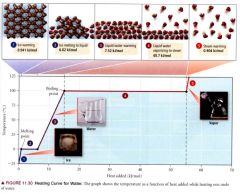
|
|
|
Phase diagram:
|
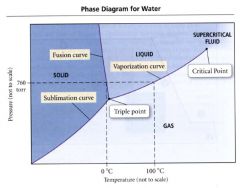
a map of the phase of a substance as a function of pressure (y-axis) & temperature (x-axis)
|
|
|
Regions on a phase diagram:
|
(s,l,g)
represents conditions where that particular phase is stable. |
|
|
Lines (curves) on the phase diagram:
|
represent a set of temperatures and pressures at which the substance is equilibrium between the two phases.
|
|
|
Triple point:
|
represents the unique set of conditions @ which 3 phases are equally stable & in equilibrium
|
|
|
critical point:
|
represents the temperature and pressure above which supercritical fluid exists.
|
|
|
Water properties:
|
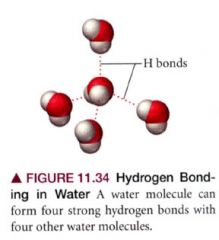
- low molar mass (18.02g/mol)
- liquid at room temperature - high boiling point because of strong hydrogen bonds with other water molecules. - can dissolve many other polar and ionic compounds. - is the main solvent within living organisms, and the environment. - expands upon freezing leading to ice being less dense than liquid water. |
|
|
cystalline solids:
|
comprising a well-ordered array of atoms or molecules
|
|
|
amorphous solids:
|
having no long-range order
|
|
|
simple cubic unit cell:
|

1 atom per unit cell. (each unit cell actually contains only one-eight of each of the eight atoms at its corners.
|

